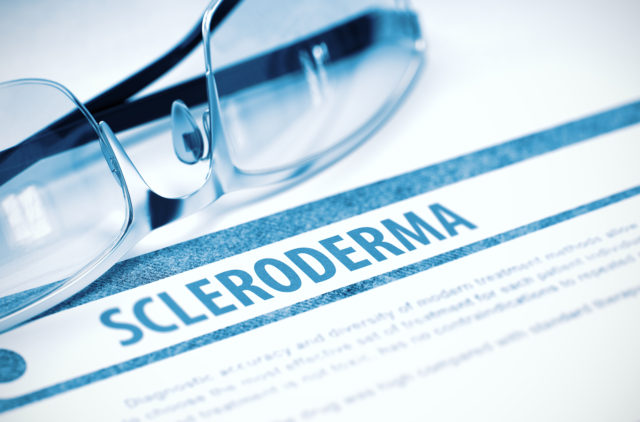
Let’s talk about a difficult condition called scleroderma. Massage therapy might not be among the resources you’d think of in addressing the patient’s challenges with this condition, but you’d be surprised. For a wide variety of conditions, massage therapy becomes a versatile tool for healthcare professionals who add it to their repertoire.
When you study the body from a massage therapy perspective, you also gain insight and ideas for your work as a yoga instructor, fitness professional, or other roles where you’re concerned with your clients’ physical wellbeing. It’s both a whole-body and localized treatment. Here’s how it helps with scleroderma when carefully used.
Scleroderma and its Stages
Scleroderma is an autoimmune condition which, like many such conditions, affects women much more frequently than it does men. It causes hardening of the body’s tissues, either locally or throughout the body’s systems, producing a thick feeling to the skin and other stiffness and internal damage.
The progression of a client’s scleroderma is an important factor in considering massage treatment. As damage to the body continues, its surface hardens and loses vitality and eventually internal organs can be affected. Massage therapy may not be advisable or may be of limited use during later stages of the disease.
The Advantages of Skilled Massage Therapists
Multimodal treatment, mixing massage therapy with treatment by physicians, nurses, and other healthcare providers, can help a patient’s body to respond better to treatment in general. If you have one of these backgrounds, you can augment your clinical skills in a significant way by learning massage therapy. For example, it can help increase blood circulation and possibly delay the onset and worsening of symptoms.
Because there are many specialized massage techniques with varying effects on the body, a carefully designed massage program can be offered to clients to address medical concerns. Where deep tissue massage may help with some aspects of a condition, your skill and tactile sensitivity as a massage therapist can help you use a gentler approach, similar to that used for fibromyalgia.
Using the Unique Qualities of Massage to Help Scleroderma Patients
Medical guidance is essential when you are working with a client who is diagnosed with scleroderma. Depending on the type and extent of a client’s condition, deep tissue massage techniques may be somewhat useful, but attention to circulation and joint function, breath and relaxation may be more productive approaches.
You can provide gentle, repetitive touch to help capillary flow and relaxation, while breathwork and assisted joint movement can help the body stay resilient. Myofascial (muscle) techniques can conflict with the hardening of the body’s surfaces, and generally you should avoid this type of approach.
Patient Engagement Makes a Difference
Massage therapy training helps you understand the body from a client’s perspective. In addition to being a caring presence in each person’s life, you learn how to constructively use touch to assist bodies in healing from disease and maintaining health. The power of one human caring for another in a safe, structured setting allows one of the most basic human needs to be addressed — that of touch.
As an autoimmune disease, scleroderma is a complex condition and patients may feel at a loss in dealing with it. From nurses to fitness coaches, when people help us with our physical well being, it’s usually with a minimum of hands-on connection and mostly verbal. When you, as a massage therapist, address specific physical challenges which the client is experiencing, you also address the patient as a whole, helping her to develop an inner strength to deal with her life’s challenges.
To learn more about how massage therapy can be beneficial for Scleroderma contact our Seattle student massage clinic

Carpal Tunnel Syndrome: What is it? And How Do I Relieve it?

In our fast-paced, technology-addicted world, Carpal Tunnel Syndrome is a common complaint. The stiff muscles and shooting pain sufferers experience can have a significantly negative impact on daily life. As a professional therapist or bodyworker, it’s likely you will work with a client who has Carpal Tunnel Syndrome. Understanding this increasingly common condition will allow you to help your clients achieve maximum relief.
What is Carpal Tunnel Syndrome?
Carpal Tunnel Syndrome occurs when pressure is exerted on the median nerve that runs through the arm and wrist. This nerve controls motion and feeling in all digits except the little finger. When the nerve reaches the wrist, it runs through a narrow structure of bone and ligament called the carpal tunnel. Constant pressure on the nerve causes it to press against the bony parts of the structure. If left untreated, the nerve will sustain damage that can cause a variety of symptoms.
- Numbness
- Loss of muscle strength
- Tingling
- Pain in fingers, hand, or forearm
- Many sufferers first notice their symptoms at night.
Getting a Diagnosis
As always, patients should seek an official diagnosis from their primary medical physician. The doctor will start with a medical history. People with arthritis, hypothyroidism, and diabetes are at higher risk of developing the condition. The doctor will ask about recent injuries or accidents affecting the head, shoulders, arms, or hands. They will also examine your daily routine. Those with jobs that require small, repetitive movements of the hands and wrists have a greater chance of their symptoms being caused by Carpal Tunnel Syndrome.
The doctor then performs a physical examination. They will check muscle strength, sensation (the ability to feel), and the general appearance of the head, neck, shoulders, arms, wrists, and hands. Some specialists may order blood or nerve tests to verify results.
Traditional Treatment Methods
Depending on the severity of symptoms, conventional treatment options for Carpal Tunnel Syndrome vary. Milder symptoms can often be treated effectively at home.
- Stop any activities that may be causing symptoms. If that is not possible, try to rest your wrists and hands often.
- Place an ice pack on wrists for 10-15 minutes at a time up to 2 times per hour to reduce discomfort.
- N-SAIDs, like Ibuprofen or Naproxen Sodium, reduce painful swelling.
- Wearing a wrist splint while sleeping can lessen pressure on the median nerve.
If symptoms are allowed to progress, more severe interventions may be necessary. Powerful anti-inflammatory medications, called corticosteroids, can be prescribed in pill form or injected directly into the wrist. While these medications can significantly reduce pain associated with Carpal Tunnel Syndrome, they do not provide permanent relief. Surgery is an option for the most advanced cases.
Other Self-Treatment Options
There are some simple steps everyone can take to decrease the intensity of symptoms and frequency of attacks caused by Carpal Tunnel Syndrome.
- Regular Stretching
- Get treated for contributing conditions.
- Maintain a healthy weight.
- Quit smoking.
- Exercise regularly.
In addition to lifestyle changes, sufferers should take measures to protect their wrists and hands.
- Keep wrists elevated when using a keyboard.
- Keep shoulders relaxed and at the sides while typing or working.
- Use the whole hand to grip items rather than just fingers.
- Switch hands during repetitive motions.
Massage Therapy for Natural Pain Relief
Certain massage techniques have been proven to relax tight muscles and fascia in the arm and shoulder and reduce pressure on the median nerve. For clients with Carpal Tunnel Syndrome, a muscle specific massage will help address holding patterns associated with repetitive use while also increasing blood flow to the affected region. Leaving your client feeling loose, refreshed, and hopefully pain-free.
Contact us today to learn more about how massage therapy can be an effective treatment for carpal tunnel syndrome.

Which Massage to Choose: Massage Types and Techniques
 Every person on this planet could benefit from receiving a massage. It’s true! Even for our nimble athletes, the rigors of training push their muscles to the limits. To heal up quicker, massage can do the trick. But more than our athletes, our pregnant mothers, our injured grandmother, those with constant stress, and those looking to maintain their aging bodies long into the golden years. Massage helps people to feel and live better and to do this work is an important calling.
Every person on this planet could benefit from receiving a massage. It’s true! Even for our nimble athletes, the rigors of training push their muscles to the limits. To heal up quicker, massage can do the trick. But more than our athletes, our pregnant mothers, our injured grandmother, those with constant stress, and those looking to maintain their aging bodies long into the golden years. Massage helps people to feel and live better and to do this work is an important calling.
When attending the Northwest Academy for the Healing Arts, students learn a variety of massage techniques. With courses led by instructors who care about you learning the proper techniques, you will be able to provide the following massage therapies for clients in your very own clinic:
Swedish Massage- This style focuses on relaxing the entire body by using long strokes along the muscles to get the blood flowing back to the heart. It helps the body by increasing oxygen in the bloodstream and releasing toxins.
Deep Tissue Massage- The primary focus is on the deepest layers of muscle tissue, tendons, and areas nearest to the bone. For people who suffer from chronic muscle tension, Deep Tissue massage therapy can do wonders for the comfort and long term health.
Myofascial Release- For those who suffer from pain and limited motion in the body, myofascial release can help reduce the discomfort. This treatment is performed by applying gentle sustained pressure into the connective tissue, known as fascia.
Injury Treatment Massage- By using combination of Swedish, deep tissue, and orthopedic technique, more oxygen and nutrients can be delivered into injured tissues, while releasing tissue restrictions thus aiding in the healing process. The improved circulation and relaxed muscles will get people back to feeling great again after enduring the challenge of an injury.
Pregnancy Massage– Those mommas out there are working hard and their body’s feel the stress of all of it. This causes pain, discomfort, numbness, not to mention the headaches and nerves of even having a baby! Gentle massage can help relieve all of those issues and provide some peace of mind to Mom as she prepares to bring her newborn into the world.
Manual Lymphatic Drainage- This massage technique encourages the drainage of the lymph, whose purpose is to carry the waste products in our body away from the tissues.
At the Northwest Academy, you will also learn the basics of anatomy and physiology, kinesiology to understand the mechanics of motion and joint anatomy, and more. You’ll also be taught the skills and given the first-hand experience of running and operating a clinic. The goal and mission of the Northwest Academy is to support you in your endeavor to passing the national exams and receiving your massage therapy license in Washington State. We aim to do that by providing you the lowest student to teacher ratio in the area, first-hand experience, mentoring and guidance as you learn the ropes of running a clinic, and even continuing education opportunities to keep you informed on the advancements in the field.
To be a licensed massage therapist is a real honor as you share in the lives of so many. The career can give you a balanced lifestyle and the ability to shape your own day. We want to help you get there.
Now enrolling for all massage school campuses – Apply Now!
Seattle Massage School | Tacoma Massage School | Bellingham Massage School
![]()





